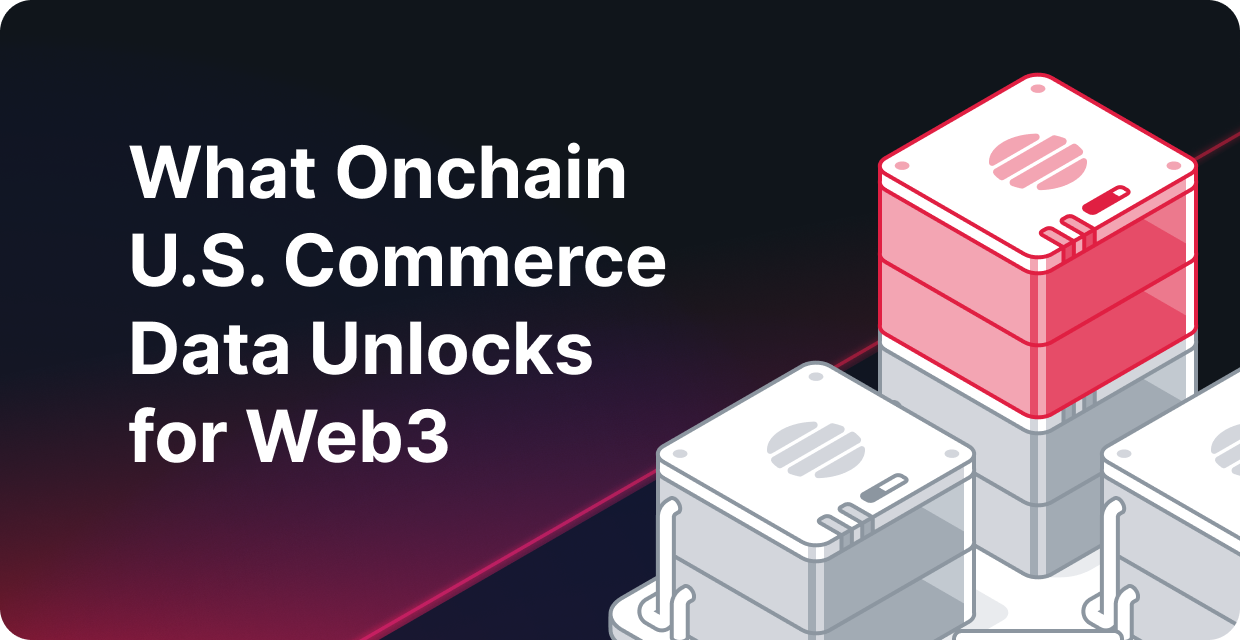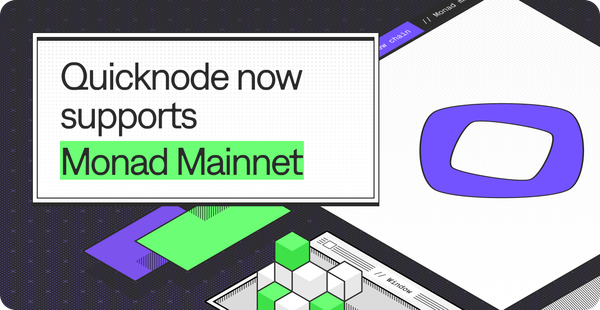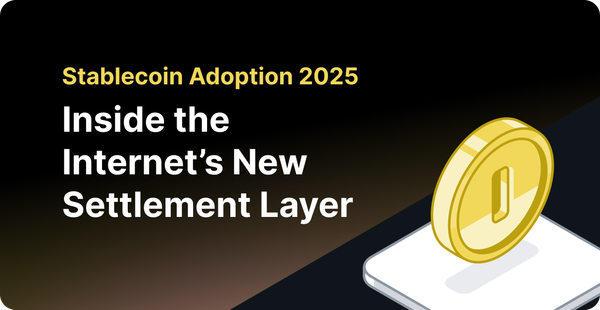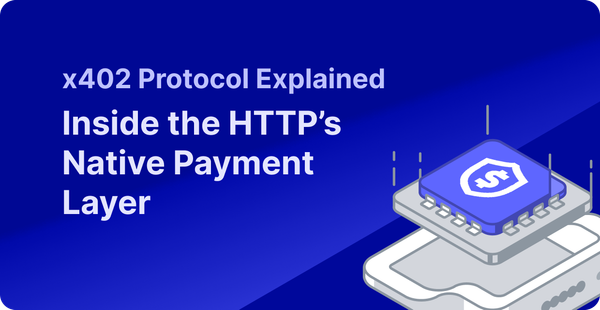Official US Economic Data Is Now Onchain: Explore the New Public Trust Layer
The US government is now publishing GDP and inflation data onchain. What this unlocks for builders, DAOs, and DeFi.

In August 2025, the US government started publishing GDP and inflation data directly on blockchains. Yes, the actual numbers on public blockchains.
Every month, when the Bureau of Economic Analysis (BEA) releases GDP numbers and similar economic indicators, billions of dollars move in traditional markets. Today, those same numbers now flow directly onto Ethereum, Solana, and eight other blockchains.
It’s huge for web3 and its convergence with traditional finance, but before everything, let’s understand what’s happening in simple English.
US Macroeconomic Data Goes Onchain: What, How, Why, and More
The US Department of Commerce (DOC), through its Bureau of Economic Analysis (BEA), is publishing official economic data directly on public blockchains.
What’s Happening
The DOC is partnering with two blockchain oracle networks, Chainlink and Pyth, to distribute BEA data across multiple chains.
Oracles are specialized infrastructure that bridge real-world information into smart contracts, making off-chain data readable and usable by onchain protocols.
The data now available includes:
- Real GDP (levels and percent changes): The total value of goods and services the US economy produces,
- PCE price index (levels and changes): The Federal Reserve's preferred measure of inflation,
- Real final sales to private domestic purchasers: The metric essentially tracks what American consumers are actually buying.
Outside these, Pyth has begun validating and distributing other critical US indicators: CPI, unemployment, wage growth, purchasing managers' index (PMI).
How It Works
The BEA still produces and releases its official reports as usual.
But now:
- The DOC hashes and posts the data directly onto multiple blockchains, creating an immutable timestamped record.
- Chainlink and Pyth act as distribution partners. They,
- Fetch the official figures,
- Verify them against the source, and
- Publish them as live data feeds that any smart contract can call.
These feeds are already available across 10+ blockchains, meaning developers can integrate GDP or inflation data into DeFi apps, DAO treasuries, tokenized bonds, insurance contracts, and more.
The data updates follow the official BEA release schedule: monthly for some indicators, quarterly for others.
Why Now
Two things came together: technical maturity and political will.
On the tech side, oracle networks are battle-tested: Chainlink alone secures over $90B in DeFi, proving decentralized data feeds work at scale.
What changed is politics.
With a pro-crypto administration and friendlier leadership at the SEC and CFTC, a federal agency could finally partner with blockchain networks and experiment.
Add to that blockchain’s unique advantages — verifiable, censorship-resistant, globally accessible, and auditable by anyone — the timing just makes sense.
Now that we have a brief idea of what’s happening, let’s zoom out and understand why these developments matter and how to best utilize them.
Web3 is Blind and Resistant to the Ground Economic Reality
DeFi has grown to over $100 billion in total value locked while operating completely blind to the economic forces that move trillions in traditional finance.
Why? Because web3 has no reliable anchor to the real economy.
- Lending protocols set interest rates without knowing if the economy is expanding or contracting.
- Tokenized treasuries, real-world loans, or onchain bonds are half blind and half delayed on off-chain inputs like interest, inflation, and employment data.
- Stablecoins are pegged to dollars as a reflexive solution but they can’t natively reflect the real-time economy.
Also, please note that this wasn't an oversight, it was a systemic constraint. The data existed, but accessing it in a decentralized, trustless way didn't until now.
What Web3 Lacks Today
Before August 2025, DeFi protocols had three bad options for economic context:
- Trust centralized data providers
Bloomberg terminals and Refinitiv APIs work for banks, but they clash with DeFi’s ethos. A permissionless protocol can’t be built on top of feeds that require KYC, subscriptions, and terms of service.
- Use crypto-native alternatives
Projects like Truflation offer faster, granular estimates of inflation. They’re clever, but they’re not the canonical numbers central banks or institutions rely on.
Approximations can’t replace official benchmarks.
- Ignore macro entirely
Most protocols do exactly this currently. Aave, Compound, Morpho, and similar protocols — all set lending rates purely on utilization curves, treating +3% GDP growth the same as a -2% recession.
Simply put, crypto and DeFi especially have grown fundamentally disconnected from economic reality. But, why does macro truly matter?
Why Macro Matters
Macro data is the heartbeat of global finance. Every major asset class moves to its rhythm:
- Bonds rise or fall with inflation and growth.
- Equities reprice when GDP surprises.
- Currencies swing on trade balances and interest rate expectations.
- Derivatives worth trillions settle on these exact numbers.
When the Bureau of Economic Analysis posts GDP growth or inflation, billions shift within seconds across Wall Street, London, Tokyo, and beyond.
Pension funds rebalance, central banks rethink policy, hedge funds trigger algorithms — all off the back of a few lines of government data.
If web3 wants to graduate to serving as real infrastructure, it needs to see and react to the same benchmarks that move the world’s capital. This is exactly what US macroeconomic data going onchain promises to unlock.
Public Trust Infrastructure, Now Composable
The US government publishing economic data on blockchains isn't just about data availability, it's about public trust itself has been turned into a programmable building block.
Here’s the simple unlock: The BEA is the canonical source for US macro stats.
By hashing and anchoring its releases onchain, and by working with Chainlink and Pyth to distribute them, that trust becomes machine-readable and composable.
The data is:
- Authoritative: Same source the Fed uses
- Verifiable: Cryptographically signed and timestamped
- Permissionless: No KYC, no subscription, no approval process
- Composable: Any protocol can integrate it into any product
- Censorship-resistant: Published across multiple chains, impossible to take down
This combination: institutional credibility meets permissionless infrastructure has never existed before.
Most importantly, this is infrastructure that behaves like public goods: open access, no excludability, available to everyone simultaneously.
Why This Matters for Builders
For builders, this shift is about new inputs, new markets, and new legitimacy.
In traditional finance, building a product that adjusts based on GDP growth means tackling and navigating:
- Licensing agreements with data providers ($10K to $100K+ annually)
- Legal review of terms of service and compliance audits
- Technical integration with specific APIs
- Ongoing subscription costs that scale with users
Each step creates barriers. The result: only large institutions build GDP-linked products, because only they can afford the overhead.
With credible onchain data, these dynamics flip completely.
What This Enables for the Mass Market
For builders, this shift is about resilient products, new markets, and network effects.
- Solo developers can build institutional-grade products
Code and build products employing the same GDP and inflation figures that central banks and institutions use. That means smarter lending curves, macro-aware treasuries, and risk models that move beyond token prices.
- New markets
Official data unlocks primitives that didn’t exist before: GDP-linked derivatives, inflation-protected stablecoins, macro hedging strategies, and prediction markets that resolve instantly.
- Network effects compound differently
Every protocol that integrates macro data makes the next integration easier. Shared standards emerge organically. Tooling gets built once and reused everywhere.
Remember, it is now that for the first time, public data and public blockchains speak the same language and builders get to decide what to make of it.
What Macroeconomic Data Unlocks: Primitives and Possibilities
Official macro data onchain is a design space that didn't exist before. A new and native design space means new primitives and possibilities.
Here are a few of them that we might see come to life soon:
Macro-Responsive Lending Protocols
Interest rates that reflect economic reality.
Protocols like Aave or Compound can adjust rates when CPI rises: depositors earn inflation-aware yield, borrowers face higher costs in overheated economies.
DAO Treasury Management
DAOs can code treasury rules tied to economic conditions.
For instance, the treasury can be coded to shift to stables if GDP contracts, or expand risk exposure in growth cycles.
Macro-Hedged Vaults
Vaults targeting ‘real yield’ could auto-shift part of assets into T-bills or stable instruments when inflation beats APY.
Macro-Based Trading and Investing Prompts
Wallets can show prompts like: “Your APY trails inflation by 1.2%—shift 20% to Short-Duration Yield?” This is simple, opt-in guidance powered by official feeds, turning abstract macro risk into everyday user action.
Index-Rebalancing
On-chain index funds can use GDP or unemployment thresholds to tweak allocations: more defensive assets in recessions, more growth exposure when the economy is strong.
Automated Collateral Revaluation
RWA protocols that adjust asset valuations when macro conditions shift. Real estate tokens marked down automatically during regional GDP contractions, marked up during growth with no manual appraisals needed.
Prediction Market Auto-Settlement
Polymarket-style markets that resolve against official government data.
"Will the US enter recession in Q3?" settles automatically when BEA releases GDP figures.
Zooming out, every example above uses some combination of existing DeFi infrastructure + newly available macro data to replicate something TradFi already does and already proves has demand. But, the difference is the permissionless composability that only web3 and onchain data offers.
Building with Onchain Macro Data? QuickNode Makes It Easy
QuickNode is an end-to-end blockchain development platform and infrastructure provider that helps developers build, scale, and ship web3 apps faster with lightning-fast RPCs, real-time data, and cross-chain tooling.
QuickNode Tools for Working With Macro Data
- RPC and Archive Nodes: Fast, reliable access to Chainlink and Pyth macro oracles across major chains like Base, Arbitrum, and Avalanche.
- QuickNode Streams: Subscribe to on-chain oracle updates in real time (e.g., trigger app logic when GDP updates).
- NFT and Token Indexing: Combine macro data with wallet-level or protocol-level insights using structured APIs.
- Multi-Chain Support: Easily integrate macro feeds from multiple chains in one place.
- Monitoring and Analytics: Track and debug oracle calls, gas usage, and feed reliability.
Onchain Macro Data: Looking at The Big Picture
The US government putting GDP and inflation on-chain marks a turning point: macroeconomic truth has entered the public blockchain stack.
It fundamentally changes the posture of web3.
DeFi can stop being self-referential and start aligning with the same signals that move trillions in traditional finance. RWAs gain stronger legitimacy. DAOs can manage treasuries with context. Developers everywhere get access to the same inputs that central banks and hedge funds use.
The convergence of public trust and public infrastructure is bigger than any single primitive.
Now, the race for macro-aware DeFi is heating up. The data is live. The infrastructure works.
What's missing is execution: which protocols ship integrations first, which primitives find product-market fit, which builders prove that macro awareness solves real problems instead of theoretical gaps.
About QuickNode
QuickNode is a leading blockchain infrastructure and solutions provider.
Since 2017, we’ve helped thousands of developers and companies scale their onchain applications with lightning-fast, reliable access to over 75 blockchains. Stay ahead in the world of web3 — subscribe to our newsletter for insights, updates, and the latest innovations shaping the future!





